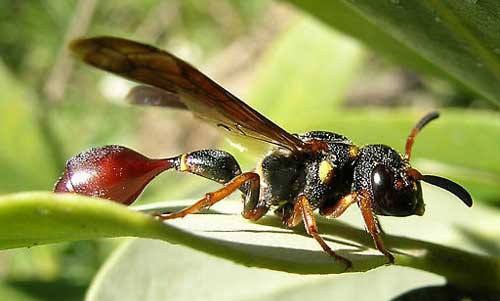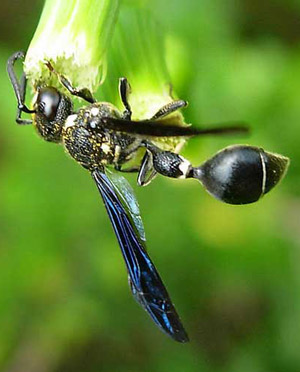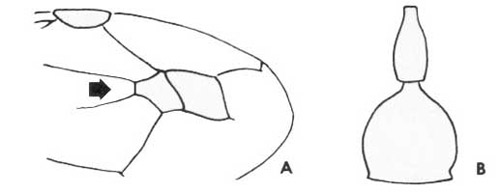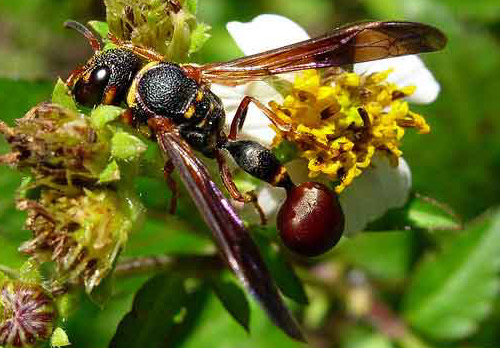common name: mason wasps of Florida
scientific name: Zethus spp. (Insecta: Hymenoptera: Vespidae: Eumeninae)
Introduction - Distribution - Identification - Biology - Economic Importance - Selected References
Introduction (Back to Top)
The genus Zethus is in the subfamily Eumeninae, which contains the mason and potter wasps. However, many Zethus species typically make their nests in twigs and branches (Porter 1978) using old insect burrows, although ground nesting is also common.
Members of the genus Zethus are widespread throughout the New World tropics. According to Bohart and Stange (1965) there are 189 recognized species in the Western Hemisphere, with the greatest number in the Brazilian region of South America. However, Porter (1978) lists only 187 in the same area. Arnett (2000) and Porter (1978) list seven species in America north of Mexico, two of which occur in Florida.
Figure 1. Lateral view of an adult Zethus slossonae Say. Photograph by Sean McCann, University of Florida.
Zethus spinipes Say has two subspecies found in the eastern United States, and Zethus slossonae Fox is known from southern Florida. Zethus are easily mistaken for potter wasps (Eumenes) commonly found around the home. Unlike Eumenes spp. which build nests of mud, Zethus use either abandoned burrows of other insects or build nests from vegetable matter and resin.
Figure 2. An adult male Zethus spinipes Fox. Notice apical curve on antenna that indicates a male. Image taken in Indian River County, Florida, so species is most likely Zethus spinipes variegatus Say. Photograph by Sean McCann, University of Florida.
Distribution (Back to Top)
Zethus slossonae is endemic to Florida from Orlando southward to Key West. Zethus spinipes occurs in two subspecific forms throughout the southeastern and lower northeastern United States. The subspecies Zethus spinipes variegatus ranges from Maryland southward to the tip of peninsular Florida and westward to Texas. The nominate subspecies ranges northward from Virginia to Massachusetts and westward to Kansas.
Identification (Back to Top)
Zethus and Eumenes are the only genera of Eumeninae with the first abdominal segments narrowly petiolate. Methods for separating Zethus from the similar appearing Eumenes were discussed in FDACS-DPI Entomology Circular 146 (Grissell 1974). The second abdominal segment of Zethus is more petiolate than that of Eumenes, and the second submarginal cell of Zethus is truncate posterobasally, while that of Eumenes is acute.
Figure 3. Zethus spp. wing (A) and abdomen (B). Drawing by Division of Plant Industry.

Figure 4. Eumenes spp. wing (A) and abdomen (B). Drawing by Division of Plant Industry.
Zethus slossonae is most readily separated from Zethus spinipes by color: Zethus slossonae is black and red with yellow markings, while Zethus spinipes is black with ivory markings. Other morphological differences, not as readily apparent as color, are given by Isely (1917) and Bohart and Stange (1965).
Figure 5. Dorsal view of an adult Zethus slossonae Say. Photograph by Sean McCann, University of Florida.
Figure 6. An adult male Zethus spinipes Fox. Notice apical curve on antenna that indicates a male. Image taken in Indian River County, Florida, so species is most likely Zethus spinipes variegatus Say. Photograph by Sean McCann, University of Florida.
Biology (Back to Top)
Bohart and Stange (1965) reviewed literature of the known biologies for 15 of the 189 New World Zethus. Nothing has been added since that time. In general, two types of nesting behavior are known. Some species use old insect burrows in twigs, wood, or in the ground. The female wasp cleans out the old burrow, lays an egg in the cell, and then provisions it with lepidopterous larvae. In some species, the cells are capped off or separated from the next cell by cemented leaf fragments. One species forms a cap of sawdust. The other type of nesting behavior involves the construction of original nests from masticated vegetable matter (usually leaves) pasted together with a resinous substance. These nests are usually fastened to shrubs, vines, or trees. Some females that make this type of nest are known to construct communal nests and each progressively feeds its own larvae until mature.
The nesting habits of Florida Zethus are virtually unknown. Both Zethus spinipes and Zethus slossonae are related to other species that use old insect burrows for nests. Ashmead (1894) reported both Zethus and Eumenes forming globular clay cells, and he claimed Zethus spinipes made cells attached to a "...twig of the irontree." This observation is almost certainly in error. Ashmead probably misidentified Eumenes (the potter wasp) for Zethus. The only biological note for Zethus slossonae was given by Bohart and Stange (1965) who saw a museum specimen reared from a twig nest. It is evident that much work remains to be done on the biology of this genus.
Economic Importance (Back to Top)
So little is known of the biology of Zethus, its economic importance is obscure. However, since members of the genus provision their nests with lepidopterous larvae (including Geometridae and Gelechioidea), many of which are considered pests, Zethus should provisionally be considered beneficial.
Selected References (Back to Top)
- Arnett Jr RH. 2000. American Insects: A Handbook of the Insects of America North of Mexico. CRC Press. Boca Raton. 1003 pp.
- Ashmead WH. 1894. The habits of the Aculeate Hymenoptera. Psyche 7: 75-79.
- Bohart RM, Stange LA. 1965. A revision of the genus Zethus in the Western Hemisphere. University of California Publications in Entomology 40: 1-208.
- Grissell EE. 1974. The Eumenes, or potter wasps, of Florida. Florida Department of Agriculture and Consumer Services - Division of Plant Industry Entomology Circular 146: 1-2.
- Isely D. 1917. A synopsis of the petiolate wasps of the family Eumenidae (Hymenoptera), found in America north of Mexico. Annals of the Entomology Society of America 10: 345-366.
- Porter CC. 1978. Ecology and Taxonomy of Lower Rio Grande Valley Zethus. Florida Entomologist 61: 159-168.




